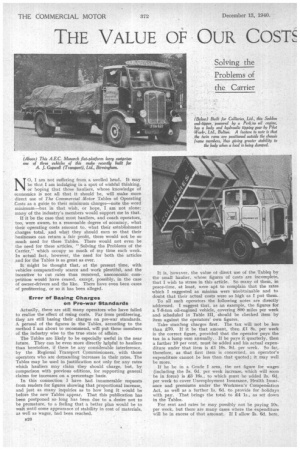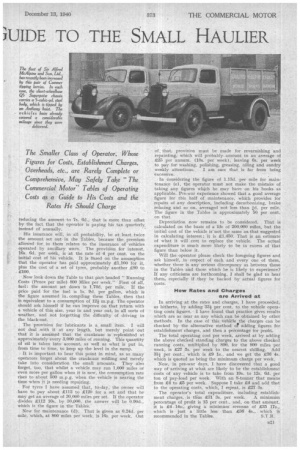THE VALUE OF OUR COST.
Page 26

Page 27

If you've noticed an error in this article please click here to report it so we can fix it.
iUIDE TO THE SMALL HAULIER 1\1 0, I am not suffering from. a swelled head. It may be that I am indulging in a spot of wishful thinking, or hoping that those hauliers, whose knowledge of economics is not all that it should be, will make more direct use of The Commercial Motor Tables of Operating ,Costs as a guide to their minimum charges—note the word minimum—bur in that wish, or hope, I am not alone; many of the industry's members would support me in that.
If it be the case that most hauliers, and coach operators, too, were aware, to a reasonable degree of accuracy, what their operating costs amount to, what their establishment charges total. .and wha,t they should earn so that their businesses can return a fair profit, there would not be so much need for these Tables. There would not even be the need for these articles, " Solving the Problems of the Carrier," which occupy so much of my time each week. In actual fact, however, the need for both the articles and for the Tables is as great as ever.
It might be thought that at the present time, with vehicles comparatively scarce and work plentiful, and the incentive to cut rates thus removed, uneconomic competition would have ceased, except, possibly, in the case of owner-drivers and the like. There have even been cases of profiteering, or so it has been alleged.
Error of Basing Charges on Pre-war Standards Actually, there are still many operators who have failed. to realize the effect of rising costs, Far from profiteering, they are still basing their charges on pre-war standards. A perusal of the figures in the Tables, according to the method I am about to recommend, will put these members of the industry wise to the true state of affairs.
The Tables are likely to be especially useful in the near future. They Call be even more directly helpful to hauliers than heretofore, if there be any considerable interference, by the Regional Transport Commissioners, with those operators who are demanding increases in their rates. The Tables may be used in justification not only for any rates which hauliers may claim they should charge, but, by comparison with previous editions, for supporting general claims for increases on a percentage basis.
In this connection I have had innumerable requests from readers for figures showing that proportional increase, and just as many inquiries as to how long it would be before the new Tables appear, That this publication has been postponed so • long has been due to a desire not to be premature, to a feeling that a better plan would he to wait until some appearance of stability in cost of materials, as well as wages, had been reached. • It is, however, the value of direct use of the Table§ by . the small haulier, whose figures of costs are incomplete, that I wish to stress in this article. So many of them, in peace-time, at least, were apt to complain that the rates which I suggested as minima were unobtainable and to doubt that their actual costs were so high as I put them. To all such operators the following notes are directly addressed. I suggest that, as an example, the figures for a 7-8-ton oil-engined vehicle, covering 800 miles per week and. scheduled in Table III, should be checked item by item against the operators' own figures.
Take standmg charges first. The tax will not be less than £70. If it be that amount, then £1 8s. per week is the correct figure, provided that the operator pays the tax in a lump sum annually. If he pays it quarterly, then a further 10 per cent, must be added and his actual expenditure under that item is £1 10s. 9d. per week. So far, therefore, as that first item is concerned, an operator's expenditure cannot be less than that quoted; it may well be more.
If he be in a Grade I area, the net figure for wages (including the 3s, 6d, per week increase, which will soon be in force) is £3 16s., to which must be added 2s. 6c1. per week to cover Unemployment Insurance, Health Insurance and premiums under the Workmen's Compensation Act, as well as a further 1s, 6d, to provide for holidays with pay. That brings the total to £4 as set down in the Tables.
For rent and rates he may possibly not be paying 10s. per week, but there are many cases where the expenditure will be in excess of that amount.. If I allow 2s. 6d. here, reducing the amount to 7s. 6d., that is more than offset by the fact that the operator is paying his tax quarterly. instead of annually.
His insurance will, in all probability, be at least twice the amount set outin the Tables, because the premium allowed for, in them "relates to the insurance of vehicles operated by ancillary users. The provision for interest, 16s. 6d. per week, is at the rate of 4 per cent, on the initial cost of his vehicle. It is lased on the assumption that the operator has paid approximately £1,100 for it, plus the cost of a set of tyres, probably another £80 to £100.
Now look down the Table to that part headed "Running Costs (Pence per mile) 800 Miles per week." First of all, fuel: the amount set down is 1.70d. per mile. If the price paid for the fuel is is. 9d. per gallon, which is the figure assumed in. compiling these Tables, then that is equivalent to a consumption of 121m.p.g. The operator should ask himself if he can improve on that return with a vehicle of this size, year in and year out, in all sorts of weather, and not forgetting the difficulty of driving in the black-out.
The provision for lubricants is a small item. I will not deal :with. it at any length, but merely point out that it is assumed that th6 crankcase is replenished at approximately every 3,000 miles of running. This quantity of oil is taken into account, as well as what is put in, from time to time, to keep up the level in the sump.
It is important to bear this point in mind, as so many operators forget about the crankcase refilling and merely take into consideration the small amounts. They also forget, too, that whilst a vehicle may run 1,000 miles or .even more per gallon when it is new, the consumption rate rises to about 500 m.p.g. when the vehicle is nearing the time when it is needing repairing.
For tyres I have assumed that, to-day, the owner will have to pay about £112 to £120 for a set and that he may get an average of 30,000 miles per set. If the operator divides £112 10s. by 30,000, the answer will be 0.00d., which is the figure in the Tables.
Now for maintenance (d). That is given as 0.24d. per mile, which, at 800 'miles per week, is 16s. per week. Out
of that, provision must be made for revarnishing and repainting, which will probably amount to an average of £25 per annum. (10s. per week), leaving 6s. per week to pay for washing, polishing, greasing, oiling and sundry weekly attentions. I am sure that is far from being excessive.
In considering the figure of 1.134. per mile for maintenance (e), the operator must not make the mistake of taking any figures which he may have on his books as applicable. Pre-war experience showed that a good average figure for this half of maintenance, which provides for repairs of any description, including decarbonizing, brake refacing and so on, averaged not less than Id. per mile. The figure in the Tables is approximately 50 per cent. on that.
Depreciation now remains to he considered. That is calculated on the basis of a life of 200,000 miles, but the initial cost of the vehicle is' not the same as. that suggested in calculating interest; it is £1,450. That is an estimate of what it will cost to replace the vehicle. The actual expenditure is much more likely to be in excess of that figure than below it.
Will the operator please check the foregoing figures and ask himself, in respect of each and every one of them, whether there is any serious discrepancy as between those in the Tables and those which be is likely to experience? If any criticisms are forthcoming, I shall be glad to hear them, especially if .they be backed by actual figures for costs.
How Rates and Charges are Arrived at
In arriving at the rates and charges, I have proceeded, as hitherto, by adding 33* per cent, to the vehicle operating costs figures. I have found that practice gives results which are as near as any which can be obtained by other methods. In the case of this vehicle the charges can be checked by the alternative method or adding figures for establishment charges, and then a percentage for profit.
The total operating cost 'per week, arrived at by adding the above checked standing charges to the above checked running costs, multiplied by 800, for the 800 miles per week,. is £27 3s. per week to the nearest shilling. Add 33* per cent., which is £9 is., and we get the £36 4s. which is quoted as being the minimum charge per week.
Now, in pre-war days, I have discovered that a good way of arriving at what are likely to be the establishment costs of any vehicle is to take from 10s. to 12s. 6d. per ton of pay-load per week. With an 8-tonner that means from £4 to £5 per week. Suppose I take £4 and add that to the operating costs, which, I repeat, is £27 3s.
The operator's total expenditure, including establish ment charges, -is tlius £31 3s. per week. A minimum percentage of profit is 15 per cent., and, on that amount, it is £4 .14s., giving a minimum revenue of £35 17s., which is just a little less than £36 4s., which is recommended in the Tables. S.T.R.




























































